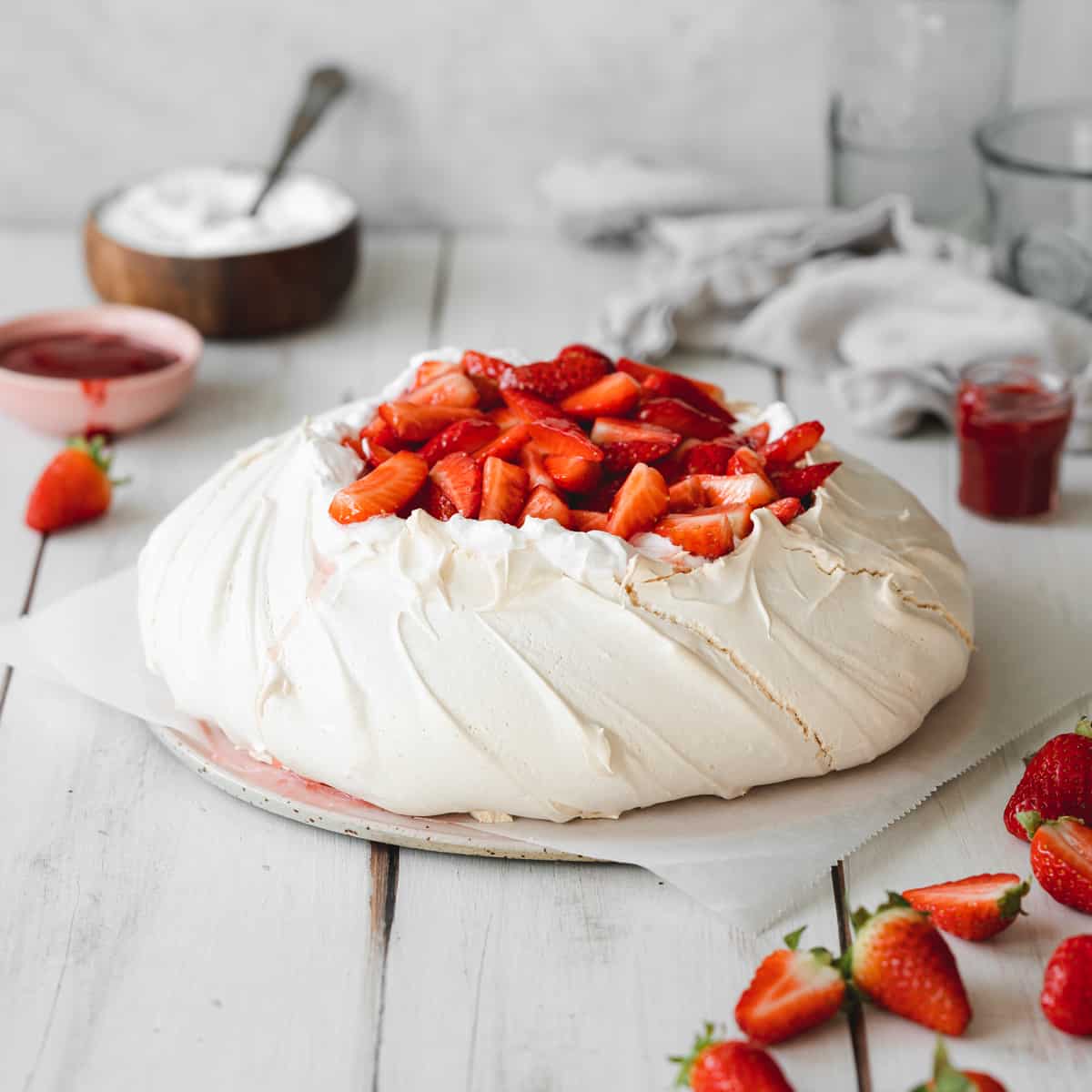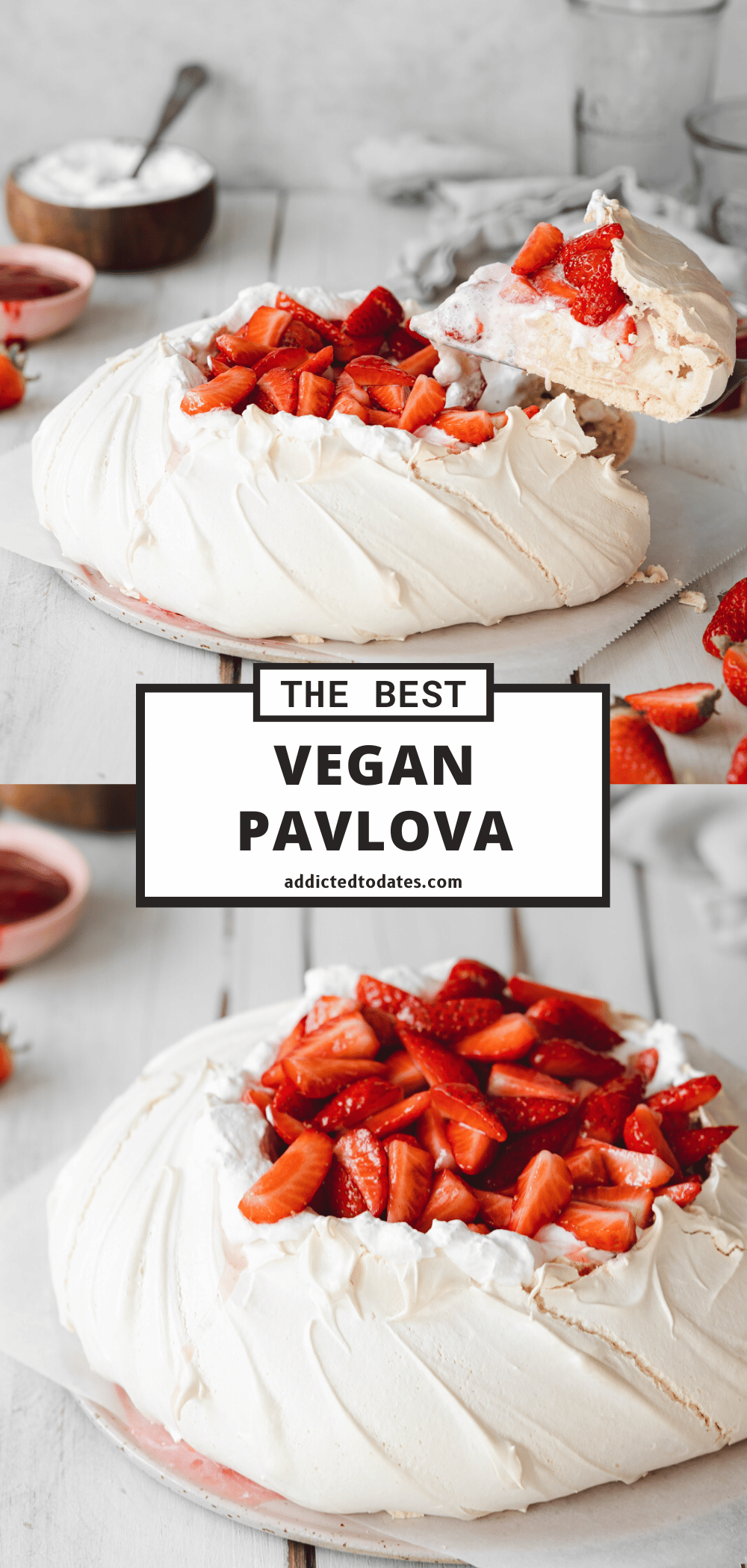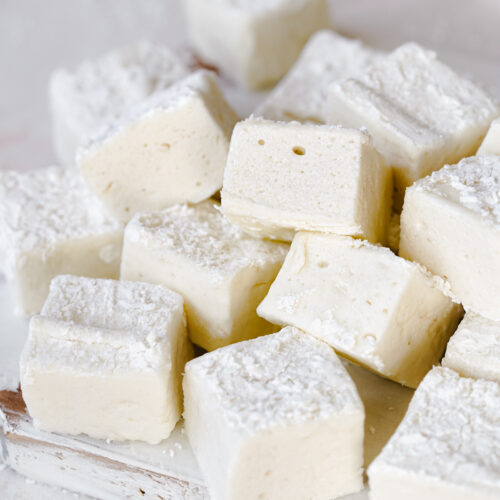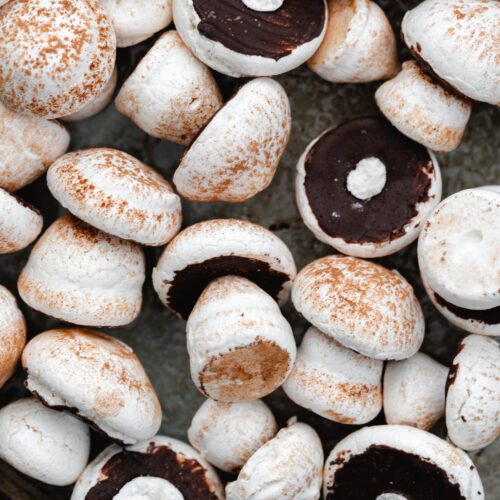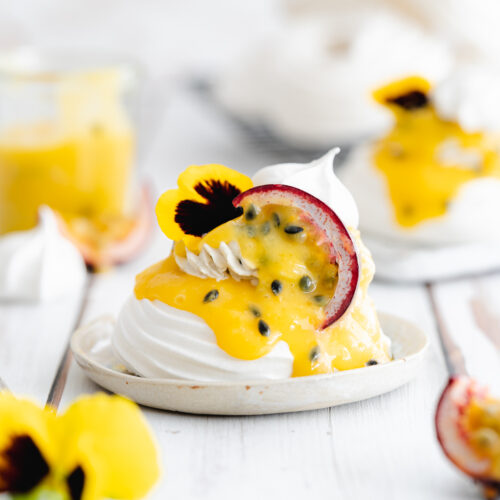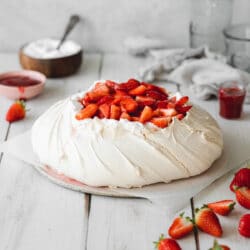This vegan pavlova is the ultimate sweet yet light dessert that's perfect for summer or special occasions.
It has all the textures you would want from traditional pavlova. A slightly crisp meringue outer shell and a soft and chewy marshmallowy center.
Just like my vegan meringue and Italian meringue buttercream recipes, it uses aquafaba and no eggs!

Jump to:
📖 Recipe Overview
Conventional pavlovas made with eggs can often have tall peaks, as egg whites help with rising. Unfortunately, aquafaba doesn't have quite the same potency as egg whites. So it took quite a bit of tweaking to get this recipe just right.
I had to adjust the oven temperature and ingredients several times in order to create an eggless pavlova that stands nice and tall!
Although this egg-free pavlova will settle and deflate slightly in the oven, so don't be surprised if it spreads a little during baking. That said, it stands much taller and is more stable than any other vegan meringue I've tried.
🍓 Ingredients Needed
To make the perfect vegan pavlova, you'll need to use these exact ingredients as they all have properties that play a vital role in the success of the recipe!

Ingredient Notes
- Aquafaba (aka chickpea water) is the brine in which chickpeas (garbanzo beans) have been cooked. It may sound gross - but I promise you won't taste it all! When whipped, chickpea brine mimics the properties of egg whites. This makes it perfect for vegan meringues and pavlova.
- Superfine sugar, which is called caster sugar in Ireland and the UK, is finely ground granulated sugar. The smaller grains dissolve into the meringue more easily than regular sugar, which prevents the meringue from weeping.
- Cream of tartar is an acidic ingredient that acts as a stabilizer and helps to create a stronger meringue. If you don’t have this to hand or want to make a vegan pavlova without cream of tartar, you can use the same volume of white vinegar in its place.
- Xanthan gum is a stabilizer and thickener and a small amount of it goes a long way! I tested this eggless pavlova recipe both with and without xanthan gum, and the version with it held up taller during baking.
- Cornstarch is whisked in at the very end, as this helps to create a chewy marshmallow center! It also absorbs any excess moisture from the meringue which helps prevent weeping. (source: King Arthur Baking).
🥣 How To Make Vegan Pavlova
Find the complete list of ingredients, quantities, and instructions in the recipe card at the end of this post.
(1) First, reduce the aquafaba. Add it to a saucepan and simmer for 10-15 minutes until it reduces by half the volume. Chill it completely before use, you can pop it in the freezer for a few minutes to speed up the process if you like.
(2) To a large clean bowl or stand mixer, add the reduced aquafaba, cream of tartar, and xanthan gum and whisk on high speed for ten minutes, until soft peaks form.
(3) Then begin adding the sugar, one tablespoon at a time, whisking for 30 seconds in between to incorporate the sugar into the meringue. Don't rush this part - the sugar needs to be completely dissolved or you could end up with a grainy pavlova that weeps!

(3) Whisk the mixture for another 5-10 minutes until thick and glossy.
(4) Add the vanilla extract and whisk to combine, then add the cornstarch and whisk again for 30 seconds or so.
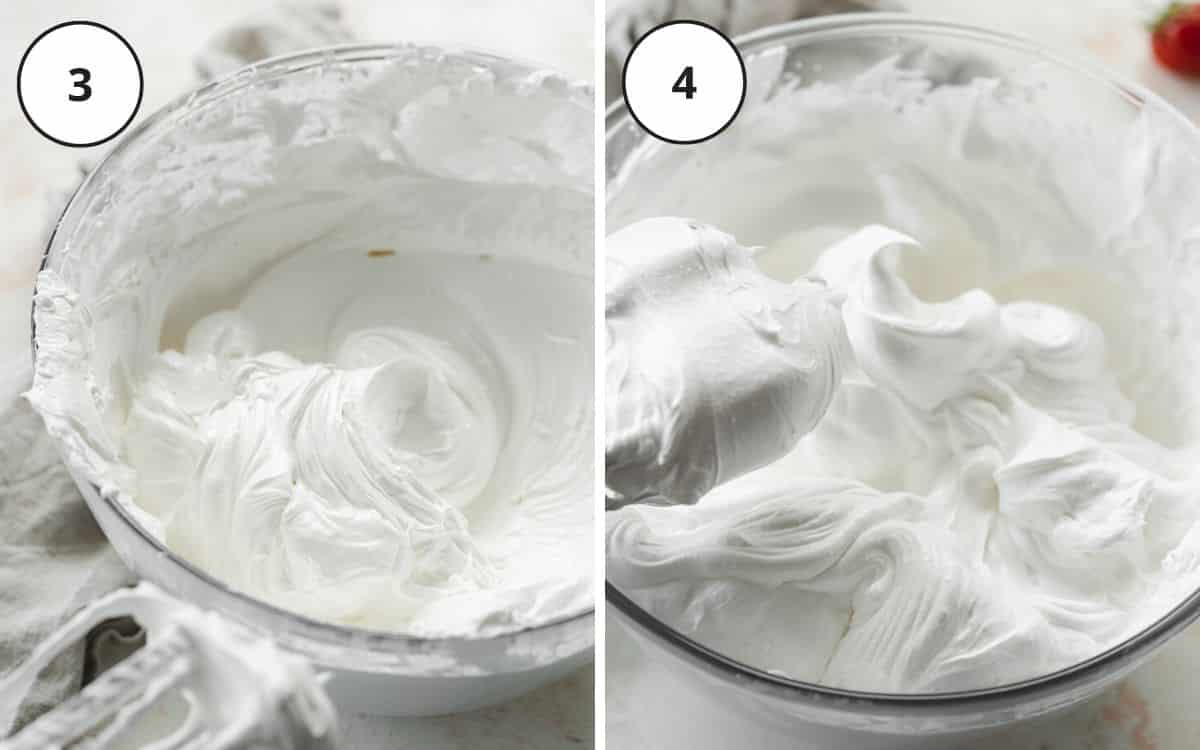
(5+6) Using a spatula, spread the meringue out onto the parchment paper-lined tray into a round disc shape. Make sure the circumference is at least an inch smaller than the tray as it will expand in the oven.
Use a spoon or spatula to lift the edges and make a crater in the center so the edges are higher.
Bake for 2½ hours WITHOUT OPENING THE OVEN DOOR. Turn off the oven, and allow the pavlova to sit in the oven for 1-2 hours. This slowly brings the pavlova to room temperature, which is key!

(7+8) Once the pavlova is completely cool, carefully transfer it to a serving plate. Just before serving, top it with non-dairy cream and fresh strawberries or fruit such as peaches, nectarines, kiwis, or raspberries.
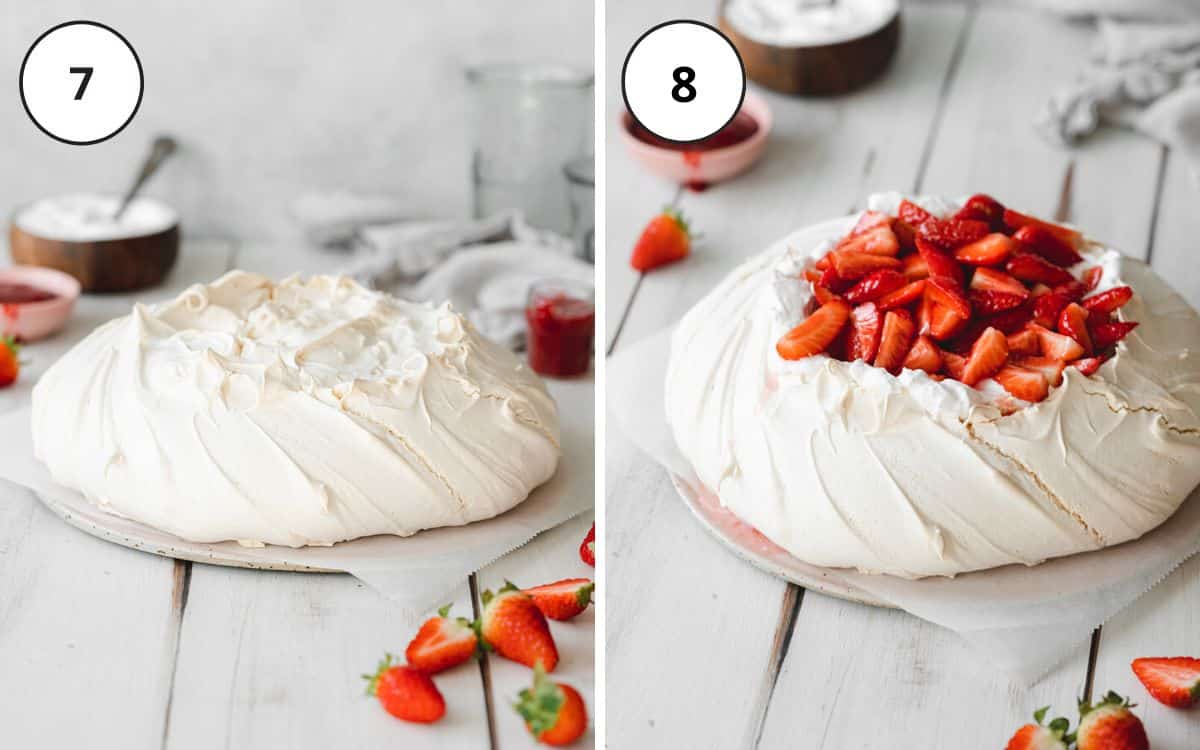
📝 Recipe Tips
Make sure all of your equipment is completely clean, dry, and free from grease before getting started. I usually wipe down everything with some lemon juice or vinegar first. This removes any grease or residue from the bowl and mixer.
Like with my vegan meringue and aquafaba meringue kisses, I always reduce the aquafaba first. I think this helps to increase the potency of the protein. This will create a mixture that most closely resembles egg whites.
Do not decorate the pavlova until right before serving. This is really, really important. Don't be tempted to add those toppings before your dinner party. Instead, wait until the moment you're presenting and serving the dish.
This vegan pavlova dessert bakes a little longer than traditional pavlova. The process of making any sort of meringue requires a low oven temperature, time, and patience! The idea is that the meringue dries out slowly at a temperature low enough not to overcook it but enough to get a nice firm outer shell.
Don't be tempted to open the oven door throughout the baking or cooling process. If you open the door, heat will escape and significantly change the oven temperature. With pavlova, it's important not to adjust the temperature too quickly, as this risks a deflated or significantly cracked meringue.
💬 FAQs
Yes, you can use white vinegar in its place.
The main reasons for this are if the sugar was added too quickly, or you did not use stabilizers (xanthan gum and cream of tartar).
Sidenote - meringues will naturally deflate once exposed to moisture, so humidity is another factor. Try to make it on a dry day, and make sure you don't add any fruit or cream until just before serving.
Aquafaba can be used from white legumes such as cannellini beans or butter beans, so it's not just chickpea water!

☁️ More Aquafaba Recipes

Love this recipe? Please leave a 5-star ★★★★★ rating in the recipe card below and consider leaving a comment as well, thanks!
Stay in touch with me through social media @ Instagram, Pinterest, TikTok, and Facebook. And subscribe via email to get all our new recipes!
📖 Recipe
Vegan Pavlova
Ingredients
Pavlova
- 350 ml aquafaba *see notes
- ¼ teaspoon cream of tartar
- ½ teaspoon xanthan gum
- 200 g superfine sugar (caster sugar)
- 1 teaspoon vanilla extract
- 1 tablespoon cornstarch (cornflour) plus extra for dusting
Topping
- 1 batch vegan whipped cream
- 400 g fresh strawberries or other berries or fruit
- ½ batch strawberry coulis optional
Instructions
Preparation (at least 2 hours prior making the recipe)
- Add the aquafaba to a saucepan and bring to a boil. Reduce the heat and allow it to simmer until it has reduced by half in volume. After 5 minutes of simmering, check the volume by pouring the liquid into a bowl on your weighing scales or measure the volume by cups (be careful as it’s going to be hot!). If there's more than half of the original liquid volume continue to simmer until it reduces to half.
- Allow the aquafaba to cool to room temperature and pour it into a jar and refrigerate to chill.
- Make sure all of your equipment is completely clean, dry, and free from grease before getting started. Wipe down everything with some lemon juice or vinegar to remove grease or residue from the bowl and mixer.
Pavlova
- Preheat your oven to 125°C (257°F). Line a baking pan with some parchment paper and dust with a thin layer of cornstarch - this will make it easier to lift the meringues once they are ready and prevent them from sticking to the paper.
- Take a large clean bowl, and add the aquafaba, cream of tartar, and xanthan gum to the bowl and whisk with an electric mixer on high speed for 10 minutes until soft peaks form. You can also use a stand mixer.
- Add the caster sugar one tablespoon at a time while continuing to whisk and incorporate the sugar into the aquafaba. Whisk in each tablespoon for about 30 seconds before adding the next. Continue this process until you have incorporated all of the sugar, then whisk for another 10 minutes until thick and glossy.
- Add the vanilla extract and whisk for a minute to combine. Lastly, add the cornstarch and whisk for another 30 seconds to combine.
- Using a spatula, spread the meringue out onto the parchment paper-lined tray into a round disc shape. Make sure the circumference is at least an inch smaller than the tray as it will expand in the oven. Use a spoon of a spatula to lift the edges and make a crater in the center so the edges are higher.
- Bake for 2½ hours WITHOUT OPENING THE OVEN DOOR. Turn off the oven, and allow the pavlova to sit in the oven and come to room temperature for 1-2 hours before opening the oven.
- Make the vegan whipped cream and strawberry coulis if using it.
Serving and Storage
- Note that the pavlova should only be decorated just before serving, as meringue begins to melt once liquids come in contact with it.
- I highly recommend that you make the pavlova on the day/evening before serving. If making the evening before, simply allow it to sit in the oven overnight before serving the following day.
- Top the room temperature pavlova with a layer of vegan whipped cream, chopped strawberries. Slice into servings and drizzle with strawberry coulis as desired.
Notes
- Aquafaba: The liquid part from tinned chickpeas.
- This vegan pavlova dessert bakes a little longer than traditional pavlova. It requires a low oven temperature, time, and patience! The idea is that the meringue dries out slowly at a temperature low enough not to overcook it but enough to get a nice firm outer shell.
- Don't be tempted to open the oven door throughout the baking or cooling process. If you open the door, heat will escape and significantly change the oven temperature.
© addictedtodates.com. All content and images are protected by copyright. If you want to share this recipe, please do so using the share buttons provided. Do not screenshot or republish the recipe or content in full. Instead, include a link to this post for the recipe. Thank you!

